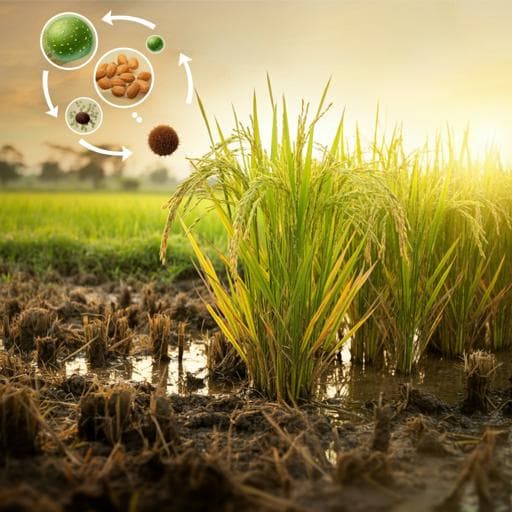
Agriculture
Effect of straw and inhibitors on the fate of nitrogen applied to paddy soil
C. Yu, X. Xie, et al.
This groundbreaking pot experiment explored how different fertilizer treatments impact nitrogen distribution and rice yields in paddy soils. Conducted by a team of experts including Chunxiao Yu and Xueshi Xie, the findings suggest that incorporating urease and nitrification inhibitors, along with straw, could be the key to maximizing rice yield in Northeast China.
~3 min • Beginner • English
Introduction
Rice occupies ~30.2 million ha in China and contributes ~50% of national grain production. Nitrogen is crucial for rice yield, yet over-application leads to low use efficiency and environmental losses. Fertilizer N in flooded paddy soils can be taken up by plants or temporarily immobilized via biotic (microbial) and abiotic (e.g., ammonium fixation) processes and then released. Management practices such as urease and nitrification inhibitors and straw return can alter N transformation and retention. Available carbon inputs (e.g., from straw) enhance microbial immobilization, increasing microbial biomass N, while inhibitors modulate inorganic N forms. Fixed ammonium (FA) is an important abiotic N pool; up to >70% of applied N can be retained as FA in some soils, with much of the recently fixed NH4+ later released. Prior studies show inhibitors can increase yield and N use efficiency on average, whereas straw return can sometimes depress yield due to inadequate late-season N supply. This study used 15N-labeled urea in a pot experiment to quantify the fate of fertilizer N among soil pools and rice, under combinations of inhibitors and straw, and to assess agronomic outcomes. Hypotheses: (1) Straw decreases N uptake and yield while increasing microbial growth and N storage in organic pools; (2) Inhibitors improve retention of urea-N through abiotic processes without added C; (3) Inhibitors with straw alleviate straw-induced decreases in N uptake and yield due to more persistent NH4+ supply.
Literature Review
Prior work indicates that added labile carbon promotes microbial immobilization of fertilizer N, increasing microbial biomass N. Responses to urease (e.g., NBPT) and nitrification inhibitors (e.g., DMPP) vary with carbon availability. Under flooded conditions, immobilization into microbial biomass can be lower, though straw generally stimulates immobilization and changes N conservation and supply. FA formation by 2:1 clays can retain a large fraction of applied N, with substantial subsequent release; its response under flooded paddy soils with straw and inhibitors has been unclear. Meta-analyses report average increases in yield (~7.5%) and N use efficiency (~12.9%) with inhibitors. Conversely, continuous straw return in irrigated systems can reduce yield, possibly due to inadequate late-season N availability, linked to stronger retention of fertilizer N in soil pools. There is a need to integrate the roles of microbial immobilization, FA, and dissolved organic N under combined straw and inhibitor management in paddy systems.
Methodology
Design: Outdoor pot experiment (net house) with rice (cv. Meifeng 9) from May–October 2018 under no-leaching flooded conditions. Five treatments in a completely randomized design: C (no N), U (15N-labeled urea), US (urea + rice straw), UI (urea + urease inhibitors + nitrification inhibitor), UIS (urea + inhibitors + straw). Each treatment had three sampling times (seedling, tillering, maturation) and three replicates (total 45 pots), with 3 kg air-dried soil per pot.
Soil: Paddy soil (Alfisol origin) collected 0–20 cm from Shenyang Agriculture Rice Institute Experiment Site (41°31′N, 123°24′E), unfertilized for 20 years. Properties: pH 6.18; soil organic matter 26.1 g kg−1; total N 1.95 g kg−1; total P 2.18 g kg−1; total K 22.4 g kg−1; CEC 22.3 cmol kg−1; texture: 16.5% clay, 55.3% silt, 28.2% sand.
Fertilization: 15N-labeled urea (10.02 atom% 15N) at 318 kg N ha−1 split 50% basal, 25% first topdressing, 25% second topdressing. P and K: 212 kg P ha−1 (superphosphate) and 318 kg K ha−1 (KCl). Inhibitors: urease inhibitors PPD and NBPT each at 1% of urea-N (w/w), and nitrification inhibitor DMPP at 2% of urea-N (w/w). Straw: rice straw (C/N 63; C 37.8%, N 0.59%), ground and applied at 10.6 t ha−1 (5 g kg−1). Basal fertilizers (± inhibitors), straw, and soil were mixed on May 25; pots flooded overnight; seedlings transplanted May 26. Topdressings (± inhibitors) were delivered in solution via syringe into soil on June 18 and August 20. Floodwater depth maintained at 3–5 cm until one week before harvest.
Sampling: Soil and plants sampled at seedling (7 days after basal fertilization, June 4), tillering (June 25), and maturation (Sept 21) using five-point sampling per pot.
Measurements: Soil pH (1:2.5 H2O); organic C (elemental analyzer); total P and K (sodium carbonate fusion and colorimetry); CEC (NH4-acetate compulsory displacement); particle size (pipette method). NH4+-N: 2 M KCl extraction, analyzed by continuous flow analyzer. Microbial biomass N (MBN): chloroform fumigation-extraction with 0.5 M K2SO4, MBN calculated using kEN = 0.54. Fixed ammonium (FA): KOBr–KOH extraction, quantification by Kjeldahl distillation and titration. Total dissolved N (TDN): alkaline persulfate oxidation; dissolved organic N (DON): TDN minus inorganic N. Total soil N: elemental analyzer. Plant biomass, grain yield (panicle), and panicle N measured at maturity after oven-drying (65°C) and grinding.
15N analyses: NH4+ 15N atom% by ammonium diffusion technique; 15MBN determined after digestion to nitrate and diffusion; 15DON by difference from 15TDN; 15FA quantified from Kjeldahl-prepared samples. All 15N determinations by isotope ratio mass spectrometry.
Calculations: N derived from urea (Ndfu) in each pool = N pool × (15N atom% excess pool)/(15N atom% excess urea). Recovery (%) = Ndfu / N applied × 100. Plant uptake of urea-N: Ntotal in rice × (% atom excess 15N in rice)/(% atom excess 15N in urea).
Statistics: One-way and two-way ANOVA (Duncan, p<0.05) using SPSS 16.0; structural equation modeling (AMOS 7) to relate urea-derived N among NH4+-N, FA, MBN, DON, TDN and soil total retention; figures by Origin 8.0.
Key Findings
- Soil total N: Generally unaffected by treatments; UIS increased total soil N at maturation compared with other treatments.
- Soil recovery of urea-N: Treatment and time effects were significant. At maturation, UI decreased urea-N recovery by 18.3%, 28.4%, and 39.4% relative to U, US, and UIS, respectively. Straw (US) promoted soil retention of urea-N, especially at tillering; UIS reduced the urea-N recovery rate by 41.29% compared with US at tillering, indicating less soil retention and more plant availability under UIS.
- NH4+-N dynamics: Urea-derived NH4+ generally decreased over rice growth, except UIS (increased then decreased). At seedling, relative to U, urea-derived NH4+ decreased by 57.8% (US), 26.5% (UI), and 64.5% (UIS). At tillering, U had the lowest fertilizer-derived NH4+, while UIS had the highest, 20 times higher than U and 23.5% higher than US. No significant NH4+ differences among treatments at maturation.
- Microbial biomass N (MBN): Straw markedly increased urea-derived MBN. Compared with U, urea-derived MBN increased by 77.9% (US) and 122.7% (UIS) at seedling, and by 191.9% (US) and 269.6% (UIS) at tillering. At maturation, MBN differences were small; U had somewhat higher MBN than other treatments.
- Fixed ammonium (FA): Both total FA and urea-derived FA followed seedling > tillering > maturation. Maximum FA recovery was ~10% at seedling, showing strong early fixation and later release. At seedling, UI had the highest FA; straw-free treatments (U, UI) showed higher FA (by 9.8% and 31.1%) than straw treatments (US, UIS). At maturation, inhibitors (UI, UIS) had lower urea-derived FA than U and US, indicating greater release.
- Dissolved organic N (DON): Urea-derived DON did not differ significantly among treatments at most times; at tillering, US increased urea-derived DON to 4.67 mg N kg−1 (3.82-fold over U). Total DON increased at seedling and tillering with UI; US decreased DON at seedling and increased at tillering; UIS increased DON only at tillering (2.38-fold over U).
- Structural equation modeling: Urea-derived NH4+ was a significant positive driver of FA (e.g., path coefficient 0.95 under UI; 0.83 correlation of extractable NH4+ with FA under US), supporting the linkage between extractable NH4+ and FA formation. Straw strengthened biotic pathways (MBN, DON) for N retention.
- Agronomic outcomes (harvest): Yield (g per pot): U 20.5, US 18.9, UI 23.1, UIS 22.0; biomass: U 67.2, US 56.0, UI 69.9, UIS 67.1. Rice urea-N uptake (% of applied): U 51.4%, US 38.5%, UI 60.7%, UIS 50.8%. Soil urea-N retention (%): U 11.5%, US 12.5%, UI 10.2%, UIS 14.2%. Unaccounted-for N (%): U 36.9%, US 48.9% (highest), UI 29.0% (lowest), UIS 34.9%. Straw reduced yield and N uptake versus U (−7.8% yield; −25.2% N uptake), while UIS alleviated these reductions (+16.4% yield; +31.6% N uptake relative to US). UI produced the highest yield and N uptake with the lowest N loss.
- Overall: Straw increased microbial immobilization and DON formation, reducing short-term plant N availability; FA served as a key early-season sink and later source of N. Inhibitors improved synchrony of N supply with crop demand, increasing yield and reducing N loss. Combining inhibitors with straw mitigated straw’s negative effects on yield while enhancing soil N retention.
Discussion
The results address the hypotheses: (1) Straw decreased N uptake and yield while stimulating microbial growth and N storage in organic pools (higher urea-derived MBN and increased DON), supporting a biotic retention mechanism that constrained immediate plant N supply. (2) Inhibitors enhanced the persistence of NH4+ and promoted FA formation early (significant NH4+ to FA pathway), improving synchrony of N supply, crop N uptake, and yield, while reducing unaccounted-for N losses; however, soil retention of fertilizer N was lower under UI, indicating potential greater reliance on fertilizer inputs long-term. (3) Combining inhibitors with straw (UIS) alleviated straw-induced reductions in yield and N uptake by maintaining higher fertilizer-derived NH4+ at critical stages and moderating excessive soil retention, while still enhancing overall soil N retention at maturation. The pronounced early FA pool and its subsequent release underline the importance of abiotic NH4+ fixation and later availability in paddy soils. These findings highlight that management integrating straw with urease and nitrification inhibitors can optimize N retention pathways and crop access to N, improving agronomic performance and potentially reducing environmental N losses.
Conclusion
A 15N-tracer pot study in flooded paddy soil showed that straw return increases microbial immobilization and DON formation, reducing short-term N availability and yield, while fixed ammonium is a major early-season N sink that later supplies N to rice. Urease and nitrification inhibitors improved N supply–demand synchrony, increasing yield and plant N uptake and reducing N losses. Combining inhibitors with straw mitigated straw’s yield penalty and enhanced soil N retention while maintaining N supply to the crop. Based on N dynamics, UIS is recommended for Northeast China paddy soils. Future work should include field-scale validation across soil types and climates, quantify gaseous N losses (ammonia volatilization, nitrification–denitrification), assess long-term soil fertility impacts of FA and organic N stabilization, and evaluate economic feasibility of inhibitor use with straw management.
Limitations
The study was a pot experiment under no-leaching conditions, limiting generalizability to field conditions. Ammonia volatilization and gaseous losses were not directly measured; unaccounted-for N was inferred. Economic analysis of inhibitor use was not conducted. Soil-specific responses (e.g., clay mineralogy influencing FA) may limit extrapolation to other regions and soil types. Field-scale, multi-season experiments are needed to confirm findings and environmental impacts.
Related Publications
Explore these studies to deepen your understanding of the subject.







